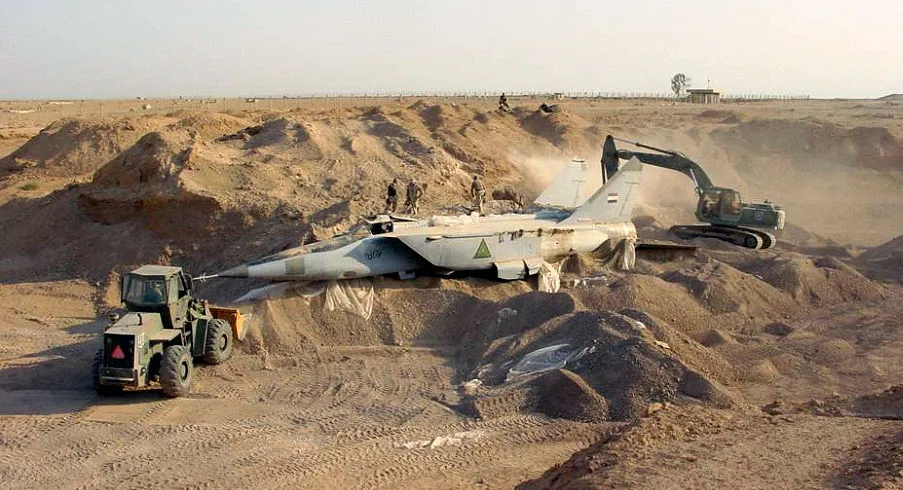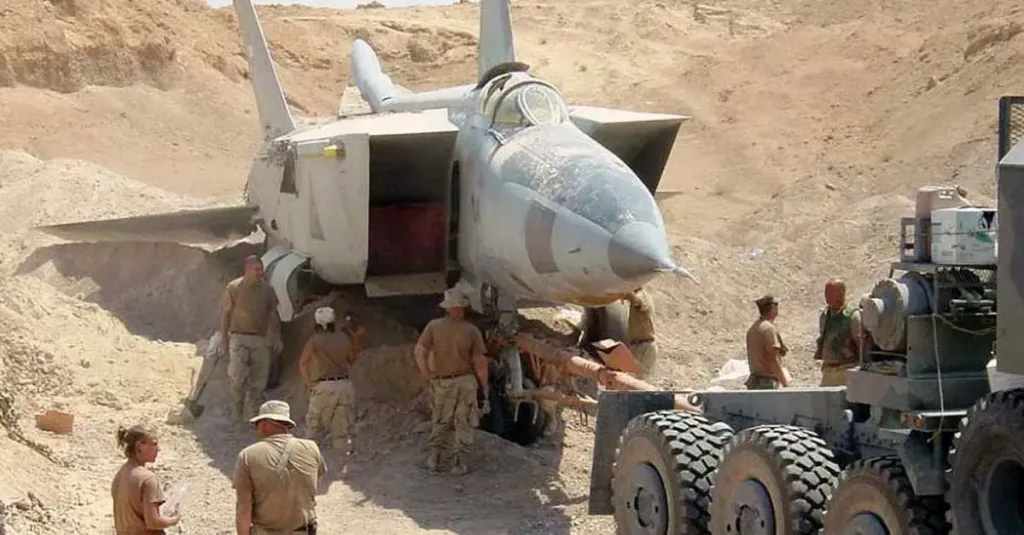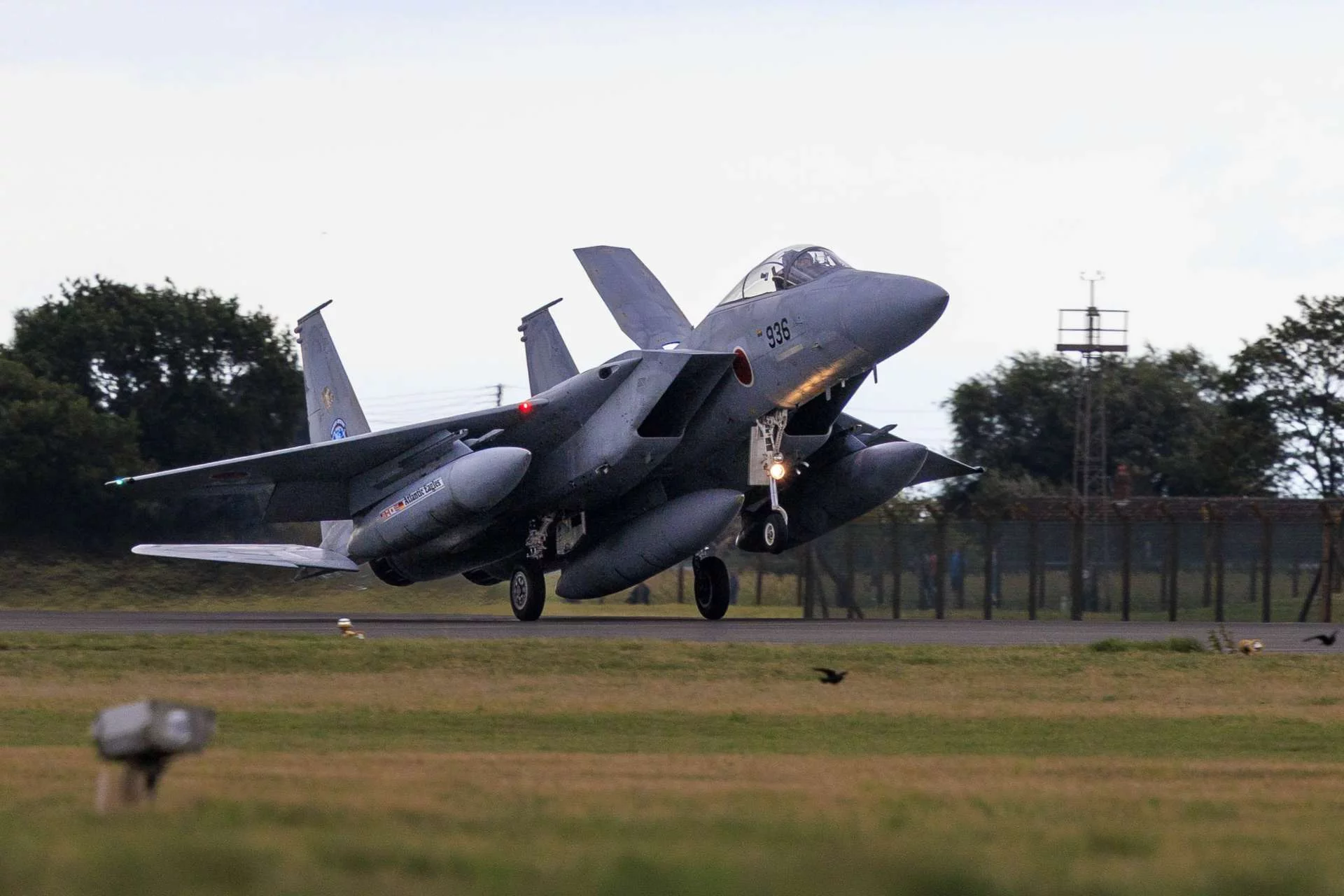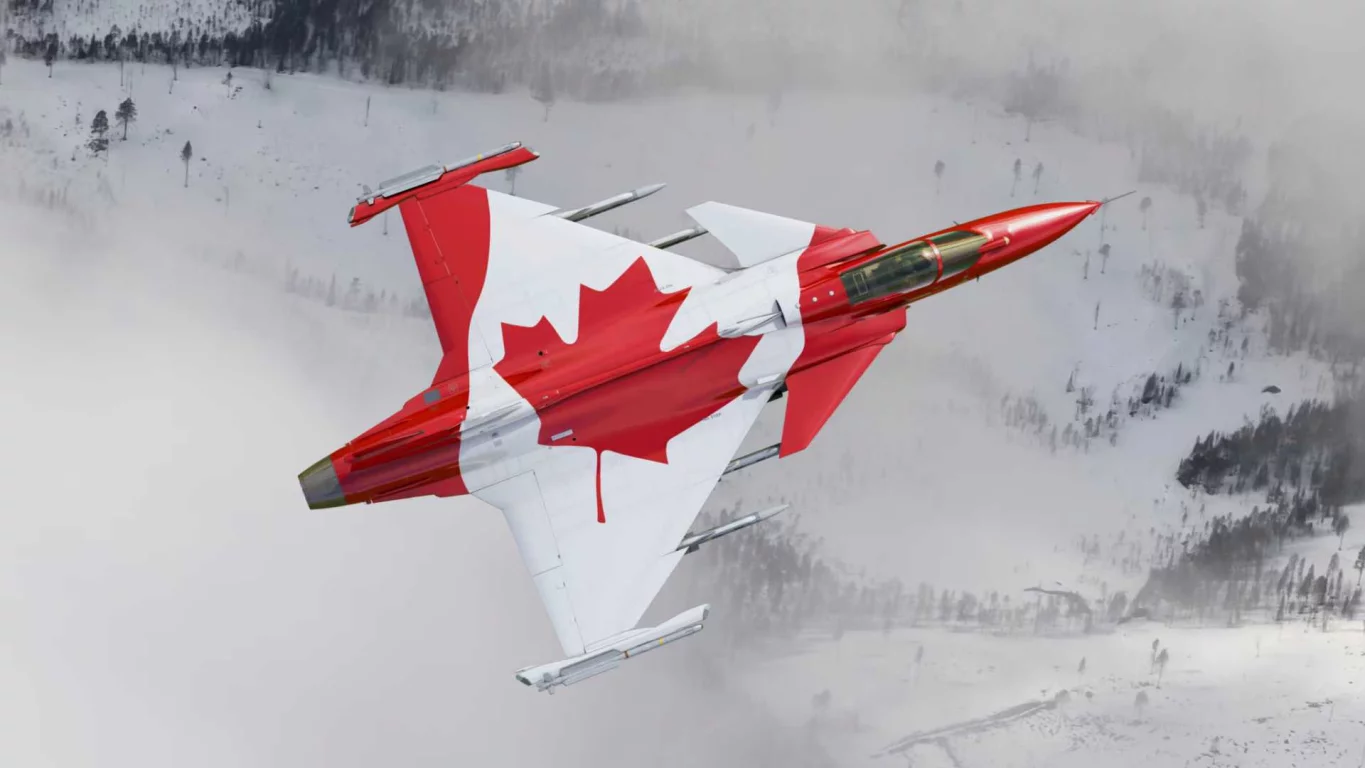In the chaotic and turbulent landscape of the 2003 U.S.-led invasion of Iraq, American forces stumbled upon a bizarre and perplexing discovery that underscored the desperate measures taken by Saddam Hussein’s regime to preserve its military assets. As U.S. troops scoured the country for evidence of nuclear, biological, or chemical weapons—commonly referred to as weapons of mass destruction (WMD)—they encountered an array of peculiar findings. From opulent gold-plated toilets and firearms to a Koran reportedly written in blood and even a romance novel penned by Saddam himself, the discoveries painted a surreal picture of the dictator’s eccentricities. Yet, among these oddities, one find stood out as particularly baffling: scores of Iraqi fighter jets, including MiG-25 Foxbat interceptors and Su-25 Frogfoot fighter-bombers, buried in the sand near fully operational airfields like al-Taqqadum and al-Asad. These aircraft, stripped of their wings but otherwise remarkably preserved, raised a critical question: why would Saddam Hussein, facing an imminent invasion by a global superpower, choose to bury his air force in the desert?
The answer lies in a combination of historical context, strategic miscalculations, and the Iraqi Air Force’s checkered past. To fully understand this unusual military tactic, we must delve into the history of Iraq’s air forces, their performance in prior conflicts, and the psychological and strategic factors that drove Saddam’s decision-making in the lead-up to the 2003 invasion. This tale is not just about buried planes but about a regime grappling with its own limitations, haunted by past failures, and desperately trying to cling to power in the face of overwhelming odds.
The Iraqi Air Force: A History of Mixed Fortunes
The story begins with the Iraqi Air Force’s evolution through decades of conflict, particularly during the Iran-Iraq War (1980–1988), a grueling eight-year conflict that shaped much of Iraq’s military doctrine. During this war, Iraq’s air force, equipped with Soviet-built aircraft like the MiG-21, MiG-23, and later the advanced MiG-25, faced off against Iran’s air force, which operated American-made aircraft such as the F-4 Phantom, F-5 Tiger, and the formidable F-14 Tomcat. The Iranian Air Force, bolstered by skilled pilots trained under the U.S.-aligned Shah’s regime, posed a significant challenge. The F-14 Tomcat, in particular, became a nightmare for Iraqi pilots. With its advanced radar and long-range AIM-54 Phoenix missiles, the Tomcat could engage multiple targets at extreme distances, often forcing Iraqi aircraft to retreat or face destruction.
Despite these challenges, the Iraqi Air Force managed to hold its own, at least in the early stages of the war. Iraq’s pilots were not without skill, and their Soviet-supplied aircraft were capable, if not cutting-edge. By the war’s end in 1988, Iraq had developed a respectable air force that could dominate regional adversaries like Syria or Saudi Arabia in a hypothetical conflict. However, the Iran-Iraq War exposed critical weaknesses in Iraq’s air defenses, particularly when facing advanced Western technology. The Tomcat’s dominance left a lasting impression on Iraqi military planners, including Saddam himself, who recognized the technological gap between his forces and those of a global superpower.
The 1991 Gulf War further underscored this disparity. When Iraq invaded Kuwait in 1990, it provoked a swift and overwhelming response from a U.S.-led coalition. Operation Desert Storm showcased the devastating effectiveness of American air power. U.S. aircraft like the F-15 Eagle, F-16 Fighting Falcon, and A-10 Thunderbolt II, supported by advanced radar, precision-guided munitions, and electronic warfare capabilities, decimated Iraq’s air defenses. Iraqi pilots, realizing the futility of engaging coalition forces, often chose to flee rather than fight. In a particularly humiliating episode, dozens of Iraqi aircraft—MiGs, Sukhois, and even French-made Mirage F1s—fled to Iran to avoid destruction. Iran, still bitter from its war with Iraq, promptly impounded these aircraft, refusing to return them. This mass defection was a blow to Saddam’s pride and a stark reminder of his air force’s vulnerability against a technologically superior foe.
Saddam’s Strategic Calculus in 2003
By 2003, as the United States issued its ultimatum for Iraq to comply with UN resolutions or face invasion, Saddam Hussein was acutely aware of his military’s limitations. The Iraqi Air Force, while still formidable by regional standards, was no match for the U.S. Air Force, which had only grown more advanced since 1991. The introduction of the F-22 Raptor, a fifth-generation stealth fighter with unmatched air superiority capabilities, further tilted the scales. Saddam knew that any attempt to engage U.S. forces in the air would result in a one-sided slaughter. His pilots, while loyal and willing to defend their homeland, were under no illusions about their chances against American technology.
Saddam’s decision to bury his aircraft was rooted in a combination of paranoia, pragmatism, and a long-term vision for his regime’s survival. The memory of the Gulf War loomed large. In 1991, Iraqi aircraft that remained on the ground or in the air were systematically destroyed by coalition forces. Airfields were bombed, runways cratered, and hangars obliterated. The planes that escaped to Iran were lost forever. Determined not to repeat this mistake, Saddam devised a plan to preserve his most advanced fighters—MiG-25s and Su-25s—for a future he believed he could still control.
The MiG-25 Foxbat, a high-speed interceptor capable of reaching Mach 3, was one of the most advanced aircraft in Iraq’s arsenal. Designed to counter high-altitude threats like the U.S. SR-71 Blackbird, it was a symbol of Iraq’s technological ambitions. The Su-25 Frogfoot, a rugged ground-attack aircraft, was equally valuable for its ability to support ground forces. Losing these assets would cripple Iraq’s ability to project power in the region, both during and after the anticipated conflict. By burying them, Saddam hoped to protect them from U.S. airstrikes and preserve them for a post-war resurgence, assuming he could weather the invasion and retain power.
The Burial Process: A Desperate Act of Concealment
The process of burying the aircraft was a logistical feat, albeit a desperate one. At air bases like al-Taqqadum and al-Asad, Iraqi forces carefully stripped the planes of their wings to make them easier to conceal. Heavy machinery was used to dig massive trenches in the desert sand, and the aircraft were lowered into these makeshift graves. The trenches were then covered, with efforts made to camouflage the sites and erase any visible signs of disturbance. The choice of locations near operational airfields was strategic: these bases were already fortified and less likely to attract scrutiny for unusual activity. The aircraft, while buried, were kept in relatively good condition, suggesting that Saddam intended to recover and restore them to operational status at a later date.
This act of concealment was not without precedent. Throughout history, militaries have hidden assets to protect them from destruction. During World War II, for example, resistance groups and retreating armies often buried weapons, vehicles, or supplies to prevent them from falling into enemy hands. Saddam’s decision, however, was unique in its scale and ambition. Burying an entire fleet of advanced fighter jets required significant resources and planning, reflecting the dictator’s determination to preserve his military power at all costs.
The U.S. Discovery and Its Implications
When U.S. forces arrived at al-Taqqadum Air Base in 2003, they were stunned to uncover the buried aircraft. Using intelligence, possibly from defectors or satellite imagery, American troops began excavating the sites, pulling out dozens of MiG-25s and Su-25s. The planes, though missing wings, were remarkably well-preserved, a testament to the care taken in their burial. The discovery was a propaganda victory for the U.S.-led coalition, further highlighting the futility of Saddam’s resistance. It also underscored the extent to which Iraq’s military had been rendered ineffective, not by combat losses but by the regime’s own strategic decisions.
The buried aircraft were a stark contrast to the other bizarre discoveries made during the invasion. Gold-plated toilets and firearms spoke to Saddam’s personal extravagance, while the Koran written in blood and his romance novel revealed his eccentric and megalomaniacal personality. The buried planes, however, were a calculated military decision, albeit a flawed one. They represented Saddam’s hope that he could outlast the invasion, reclaim his aircraft, and reassert Iraq’s dominance in the region. Instead, the discovery of the planes became a symbol of his regime’s collapse.

Why Did Saddam’s Plan Fail?
Saddam’s decision to bury his air force was, in hindsight, a strategic miscalculation born of hubris and desperation. Several factors contributed to its failure:
- Overestimation of Regime Survival: Saddam believed he could survive the U.S. invasion, either through guerrilla resistance or international pressure to halt the war. He underestimated the coalition’s resolve and the speed with which his regime would collapse.
- Underestimation of U.S. Intelligence: The U.S. military’s ability to locate and uncover the buried aircraft suggests that Saddam’s concealment efforts were not as effective as he had hoped. Satellite imagery, human intelligence, and advanced detection technologies likely played a role in exposing the hidden planes.
- Neglect of Operational Readiness: By burying his aircraft, Saddam effectively sidelined his air force during the invasion. While this prevented their destruction in combat, it also meant that Iraq had no air defenses to counter U.S. airstrikes, accelerating the regime’s downfall.
- Logistical Challenges: Recovering and restoring buried aircraft would have been a monumental task, requiring time, resources, and expertise that Saddam’s regime no longer possessed after the invasion. Even if he had survived, the practicality of unburying and reassembling the planes was questionable.
The Legacy of the Buried Air Force
The discovery of Iraq’s buried air force remains one of the most intriguing footnotes of the 2003 invasion. It encapsulates the paranoia, ambition, and ultimate futility of Saddam Hussein’s regime. The MiG-25s and Su-25s, once symbols of Iraq’s military might, became relics of a failed strategy, unearthed not by a triumphant dictator but by the very forces he sought to evade.
For military historians, the buried aircraft offer a case study in the lengths to which a regime will go to preserve its power. They also highlight the challenges of maintaining a modern air force in the face of overwhelming technological superiority. The Iraqi Air Force, once a formidable regional player, was reduced to a collection of buried hulks, a testament to the devastating impact of U.S. military dominance.
In the broader context of the Iraq War, the buried planes are a reminder of the complexities and contradictions of Saddam’s rule. His regime was marked by grandiose displays of wealth and power, yet it was ultimately undone by its own strategic missteps. The gold-plated toilets and buried jets, while vastly different in purpose, both reflect a leader obsessed with control and legacy, even as his world crumbled around him.
Conclusion
The story of Iraq’s buried air force is a fascinating chapter in the history of modern warfare. It reveals the lengths to which Saddam Hussein went to protect his military assets, driven by a mix of fear, pragmatism, and delusion. The MiG-25s and Su-25s buried in the sands of al-Taqqadum and al-Asad were not just aircraft; they were symbols of a regime’s desperate bid for survival. Yet, in the end, they became relics of a failed strategy, uncovered by the very forces Saddam sought to outmaneuver. The buried planes, like the gold-plated toilets and the blood-written Koran, are enduring images of a regime that was as audacious as it was doomed.




